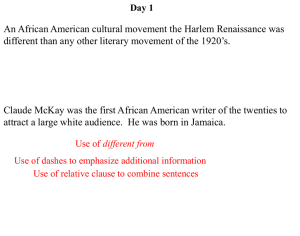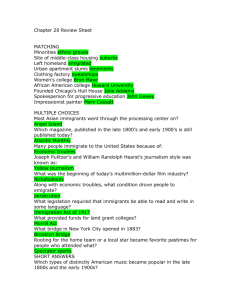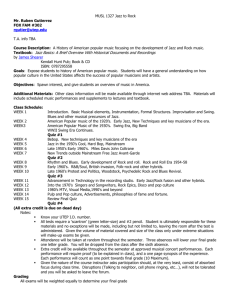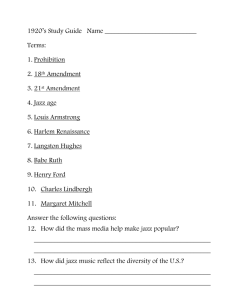From Africa to Rock and Roll - Centennial Elementary School
advertisement
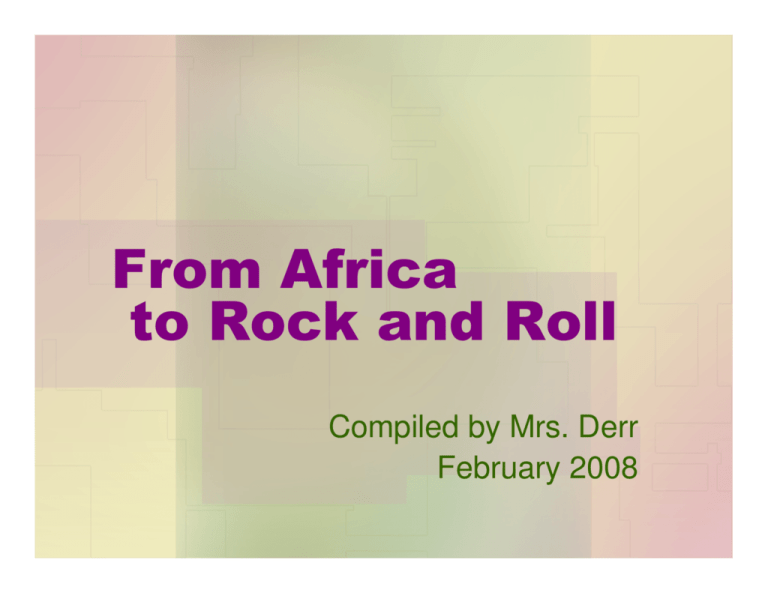
From Africa to Rock and Roll Compiled by Mrs. Derr February 2008 Early days of America In 1619, the first Africans were brought to the state of Virginia. They were taken from their happy homes and were forced into crowded ships. When they arrived in America, they were treated very poorly. The slaves were sold at auctions. They didn’t speak the language of the new land, and they were separated from their families. They were forced to do hard labor. To make the time go by faster, they began singing songs. Following African custom, a leader sang and the other workers sang along, trying to catch the rhythm that would soothe them in their work. This was the first African American musical form: THE WORK SONG. Spirituals In the early 1800’s the slaves began adopting the religion of their new world. In church they stressed their own cultural identity with songs and dances. With these songs, they expressed their hope for freedom, and a more dignified life. AFRICAN AMERICAN SPIRITUALS One of the earliest forms of American folk songs are the SPIRITUALS. No one knows who wrote these songs – they were handed down through generations. Famous spirituals include: • This Little Light Of Mine • When the Saints Go Marching In • He’s Got the Whole World In His Hands **Book by Ashley Bryan: LET IT SHINE Scott Joplin and RAGTIME In the late 1800’s and early 1900’s, another ancestor of jazz was very popular. Scott Joplin, often called the FATHER OF RAGTIME, composed this lively, rhythmic music for piano. MAPLE LEAF RAG by Joplin His composition MAPLE LEAF RAG, published in 1899, was the first published piece of sheet music to sell a million copies! **JOPLIN CD: Track 1, Maple Leaf Rag THE BLUES The blues sprang out of the southern United States as a way of expressing the worries, joys, and dreams that African Americans had along the road to being accepted in white society. Famous early blues musicians include Robert Johnson and Bessie Smith. Purple Hist./Jazz CD, tracks 2 (Keep off the Grass by James Johnson) and #11, (Back Water Blues by Bessie Smith) THE BLUES SCALE • Learn the blues scale by listening to the jazz melody blocks on the cassette tape. Funtime Blues Pack, pp. 6-7, and cassette NEW ORLEANS DIXIELAND JAZZ In the early 1900’s, the new style of African American music, which was now called JAZZ, found its home in New Orleans. JOE KING OLIVER Joe Oliver was one of the early and very important figures in New Orleans jazz. LOUIS ARMSTRONG As a young man growing up in the poorest neighborhoods of New Orleans, Louis Armstrong loved to hear the music of Joe King Oliver and his band. Louis ended up in jail for shooting a gun up in the sky during a New Orleans celebration of New Year’s Eve. It was while he was in jail that he began to play the cornet, another form of trumpet. There was a boy’s band in the Colored Waif’s Home where Louis was sent. He started out playing tambourine and drum, but then was given a bugle, and finally a cornet. Louis became one of the greatest jazz trumpeters and singers of all time. Louis Armstrong CD (1, 3, 4, 24) and Purple CD track 23 In the 1920’s, Jazz EXPLODED! The composer GEORGE GERSHWIN developed an unusual musical style which combined CLASSICAL MUSIC with JAZZ. Gershwin’s crowning achievement in this style was the piano and orchestra composition RHAPSODY IN BLUE. Gershwin CD, track 2 He wrote the entire piece in only 2 months! HARLEM JAZZ Harlem is a section in New York City with a primarily black population. In the 1920’s, the area experienced what is referred to as THE HARLEM RENAISSANCE, when musicians, artists, writers, and poets created legendary works of art. DUKE ELLINGTON Duke Ellington was a classy, elegant African American man who became the top attraction in Harlem at THE COTTON CLUB. Green Jazz CD, tracks 2, 4, 23 THE GREAT HARLEM PERFORMERS Fats Waller was a pianist, singer, and composer, best known for this comical song. Blue Jazz CD, track 10 Cab Calloway is known as the king of “Hi de hi de ho.” KANSAS CITY JAZZ In the 1930’s, Kansas City became the home of experimental jazz. JAM SESSIONS became very popular. Count Basie was a significant leader in this new movement. Green CD track 17 Other important names in Kansas City jazz: • Lester Young • Art Tatum The Voices of Jazz Billie Holiday, known as Lady Day, was only sixteen years old when she burst on the jazz scene as the singer for Benny Goodman’s band. She had a tragic life, and was able to sing with intense emotion. Ella Fitzgerald won a talent contest in 1934, and then became known as one of the greatest singers and masters of SCAT in jazz history! Carmen McRae was a follower of Billie Holiday, and sang with a pure, elegant bluesy style. The Big Band Era During WWII, jazz was considered a symbol of hope and solidarity for American soldiers. Glenn Miller was the most important figure in BIG BAND MUSIC. Glenn Miller was a trombone player and band leader, and the director of the Air Force Orchestra. Sadly, he was killed during the war in a plane crash while flying to Paris for a concert. BEBOP In the late 1940’s, some jazz musicians wanted to break away from traditional jazz and create a new sound. The new sound enabled the musicians to have more freedom of expression, with its fast paced rhythms and unusual breaks. BEBOP was especially popular in large cities. Charlie “Bird” Parker Charlie Parker was the most exciting soloist in the new BEBOP sound, with his incredible skills on the saxophone. The intense emotion of his music reflected his tormented life. Dizzy Gillespie Dizzy was a great trumpeter who also dominated the BEBOP scene. He had an infectious personality which made him very popular, and his style of puffing out his cheeks while playing was his trademark. Rhythm and Blues After WWII, many African Americans from rural areas were moving into American cities to work for defense companies. They brought with them their musical tradition of gospel and blues, which then crossed paths with big band music. The result: RHYTHM AND BLUES. Ray Charles Ray Charles was a pianist, singer, and saxophonist, emphasizing the religious background of the music. His music is considered a forerunner of SOUL. James Brown Remembered as the “Godfather of Soul,” James Brown went back to the rhythmic roots of AfricanAmerican music, and proudly imitated these sounds as a beloved singing performer. The BOP of the 1960’s In the 50’s and 60’s, there was a movement for African Americans to return to the roots of jazz. Miles Davis and Thelonius Monk lead this new movement. Free Jazz The late 1960’s changed jazz. America was in a time of turmoil, and jazz became free and without rules. John Coltrane lead this FREE JAZZ movement. What does this have to do with rock and roll? In the 1940’s, the music of African Americans was primarily jazz (which in turn became rhythm and blues), and white music was either country or very schmaltzy pop, as demonstrated in hit recordings by artists such as Doris Day and Pat Boone. Chuck Berry When white country and western music, which was popular in the South, converged with rhythm and blues, the rock and roll revolution was born. In 1954, rock and roll found its KING. Elvis Presley came from Memphis, and loved African American music with a passion. Young people of the 1950’s loved his music because it was the perfect combination of rebellion and entertainment. He wore sideburns, a stray forelock of hair on his forehead, and always looked like he was smirking. Little Richard He wore makeup, howled, abused the piano, and sold A LOT of records, starting with his first hit, Tutti Frutti. Buddy Holly Buddy didn’t look like a rebel or a rock star, but in his extremely short career he recorded an astonishing number of hit records, including That’ll Be the Day and Peggy Sue. His style was called rockabilly. Folk Rock Several white musicians in the 1960’s reverted to folk music that told stories of poor people and those who lived on the edge. Bob Dylan, a young man from the Midwest with a harsh, nasal voice, used this form of music to take on political themes. The Kingston Trio They popularized a wide range of folk music, particularly songs which protested the war. The Fab Four In the early 1960’s, four poor boys from Liverpool, who had grown up listening to Elvis, Chuck Berry, and Buddy Holly, created a totally new style of music. There influence was greater than any before in popular music – and still is. John, Paul, George, and Ringo While the Beatles were gaining fame, SOUL music was exploding as well. MOTOWN, a Detroit record label formed by African American businessman Berry Gordy, was the first African American label to record and distribute music by African American artists. The result was a captivating brand of pop music that won over both blacks and whites. Motown was the music of INTEGRATION. Motown Artists included: The Supremes The Temptations Marvin Gaye The Electric Genius The electric guitar played a leading role in the history of rock and roll. Jimi Hendrix, a young African American from Seattle had AMAZING control over his guitar, and was able to reproduce practically any sound, and to create totally new ones. The Fender Stratocaster was the guitar of choice for Hendrix. Hard Rock Between the 1960’s and 1970’s came the birth and explosion of hard rock, which eventually was called heavy metal. Hard rock is a direct descendant of the blues, but the sound explodes with loud bass, distorted electric guitars, and screaming vocals. Singer-Songwriters In the early 1970’s, a new movement arose in rock music. Singer-songwriters were individuals who returned to the roots of American popular music: the rhythm and blues, country, and folk. I Want My MTV In the 1980’s, videos became a new way to promote rock music. In response, MTV was the first television channel to broadcast music videos 24 hours a day. Artists who benefitted greatly from music videos in the 1980’s include Madonna, Michael Jackson, and the group Queen. Techno-Pop Also in the 1980’s, popular music became infused with electronic music with a dance beat. This was a continuation of a sound that had become popular in the late 1970’s, called DISCO. RAP and the Ghetto Beat The roots of rap go back to the blues and African music. RAP was born in the ghetto streets and underground clubs, and is the voice of restless young African Americans. The first rap song to reach the top of the charts was 1979’s “Rapper’s Delight.” Rap music exploded in the 1980’s, thanks to the African American community. A rap song is based on a short musical idea, and repeated over and over. The words often describe the reality of ghetto life in harsh language, along with expressions of pride in African American identity. Kris Kross The rap duo KRIS KROSS is best known for the song I MISSED THE BUS from their triple-platinum album Totally Krossed Out. Boy Bands, Computerized Voices, American Idol, and The Disney Channel American popular music is firmly rooted in both African and African American music, but many times you wouldn’t recognize these roots! A few current stars of American popular music:


